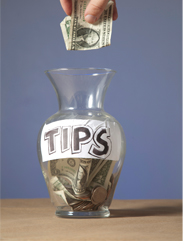 That empty wallet may mean you're a trendsetter! A recent study found that consumer use of cash in the United States is declining at an annual rate of about 3 percent, which suggests that cash payments will decline by an estimated $200 billion by 2015. With the proliferation of debit and credit cards, the emergence of smartphone-based payment processing technologies and continued use of checks, cash simply isn't convenient anymore.
That empty wallet may mean you're a trendsetter! A recent study found that consumer use of cash in the United States is declining at an annual rate of about 3 percent, which suggests that cash payments will decline by an estimated $200 billion by 2015. With the proliferation of debit and credit cards, the emergence of smartphone-based payment processing technologies and continued use of checks, cash simply isn't convenient anymore.
This evolution of the payments system has given rise to a unique problem -- what do you do about tipping if you're out of cash? Let's face it, the tip jar is a fixture in coffee shops, cafes and quick-service restaurants, but if you have no cash to put in it, you can't tip.
Or can you?
A new trend in payment processing provides a 21st century solution to this uniquely 21st century problem. It's known as the "dip jar," and it's essentially an electronic tip jar that takes credit cards. The dip jar is promoting itself as just the ticket for cafes and quick-service restaurants that use credit card payment processing technologies, but don't have a system set up to allow customers to add tips when making card payments.
The way it works is simple: instead of slipping a dollar bill or some change into a tip jar, you simply swipe your credit or debit card and your barista and server receive a $1 tip. It's quick, convenient and allows you to avoid "stiffing" the staff and getting a less than stellar frappuccino.
So now that we've solved the cash free situation, we offer a tipping cheat sheet to guide you:
• Inquire ahead of time as to whether or not tipping is included on your bill. Some restaurants automatically add a 15 percent gratuity to patrons' checks, making additional tips unnecessary. Oddly enough this is usually printed in 4 point type on your menu, so beware.
• Tip a barista the same way you would tip a bartender -- a dollar per drink is a good rule of thumb. Many would argue that being a barista requires at least as much skill -- if not more -- than being a bartender. (Ever wait in line behind the person who orders a soy latte, extra hot, with a sprinkle of freshly grated cinnamon and organic, free trade coffee beans from the mountains of Colombia? The barista really earns that buck.)
• It's becoming increasingly customary to offer a modest tip in quick-service restaurants. Many people round up to the nearest dollar, but the end amount is entirely up to you.
• While you may choose to leave a smaller-than-usual or no tip at all for poor service, dissatisfaction is not always the server's fault. For example, if you weren't happy with your food, that's the kitchen's fault -- not the server's. Tip the server and voice your complaint.
However and whenever you decide to tip, the dip jar is a good example of how payment systems adapt to consumer need. Next time you're faced with a tip jar, and that will probably be soon, think about how our payment choices have changed over the years and how we continue to adopt new ways to pay and new ways to process our payments.
Cash, checks, debit or credit? Tell us what your favorite way to pay is.


